This is a Veteran Owned site
![]()
 |
This is a small sampling of the dozens of tools sharpened during the 40+-hours logged on the JET Wet Sharpener for this review! Click image to enlarge |
JET Slow Speed Wet Sharpener
New thinking on old ideas = big value
Text & photos by Tom Hintz
Posted – 10-1-2006
NOTE: I am aware of the "Imitator report" and will address some of those points in the upcoming JET/Tormek Sharpener Side-By-Side Comparison. Thanks to all who emailed copies of that "report" to me!
It was inevitable. Sooner or later someone would produce a new sharpening machine with characteristics similar to the Tormek SuperGrind. I was a little surprised when it turned out to be a company with the engineering, manufacturing and distribution horsepower that JET (and parent company, WMH Tool Group) brings to the table. My previous experience with JET machines made checking out the new JET Slow Speed Wet Sharpener a no-brainer.
I should add that I have several years’ experience with the Tormek and have been a supporter of that system against some of its more price-conscious foes. While I have no complaints about the Tormek’s performance, I am always curious about new ideas, especially those that enhance function and save money. The JET Wet Sharpener appeared to fit both of those criteria making it a natural for a NewWoodworker.com LLC Tool Review.
Initial Impressions
The basic layout of the JET Wet Sharpener is similar to the Tormek. To be fair, if you are going to make a slow speed wet grinder with honing capability, how different can it look? Nearly all woodworking equipment, including table saws, bandsaws and lathes use the same basic configuration because it is the most logical and efficient. For the end users, this core standardization in the industry makes more aftermarket pieces and consumables more compatible. That makes life easier – and often cheaper - for us in the long run.
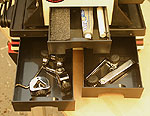 |
 |
 |
The JET Wet Sharpener package I have came with the two-drawer base (top) that also includes cord storage ears (middle) on the side. The cover (bottom) even has a Velcro closure that makes the handle accessible! Click images to enlarge |
The JET Wet Sharpener appears well built and feels solid in operation. The wide-flanged water reservoir is only the most obvious new thinking from the JET engineering/R&D folks. The fully enclosed cabinet that keeps the inner workings cleaner is another. However, a pair of dials, one on the front and another on the rear, give the operator control over the rpm at which the grinding and honing wheels turn, increasing the consistency and efficiency of the JET Wet Sharpener.
Included Accessories
NOTE: As frequently happens with new products, the contents of the base package may be altered along the way. Be sure to read the list of accessories included when purchasing any machine.
In addition to the basic JET Wet Sharpener machine, the stone and honing wheels, JET adds a few more goodies to get you going. The Support Arm (SA-1), Stone Grader (SG-1), Straight Edge Jig (SEJ-1), Honing Compound, Angle Measuring Device (AMD-1), Existing Angle Measuring Device (AMD-2), 2-Drawer Base (AB-2-2), Machine Cover (MC-1), Instructional DVD and printed parts breakdown are also part of the package reviewed here.
JET offers a full range of jigs for use with the JET Wet Sharpener that greatly extend its usefulness in the shop. Whether purchased individually or in pre-packaged sets, there are jigs available that allow virtually every user to get the most from this machine.
NOTE: NewWoodworker.com LLC will present individual reviews on many of the JET jigs to provide the in-depth coverage each deserves. See the Resources list at the end of this review for a link to that page.
Instructions
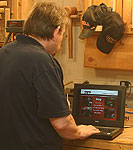 |
The JET Wet Sharpener includes a full-length DVD that illustrates the necessary setup and operating instructions plus provides in-depth looks at all of the jigs that are available for it! Click image to enlarge |
In place of a printed instruction manual, JET makes use of the popular DVD video format to provide extensive “show-you-how” information. Everything from setting up and using the JET Wet Sharpener and tutorials on all of the JET jigs is on the DVD. The video presentation features Ernie Conover, a well-known woodworking author/instructor in addition to his role as the guiding power behind the Conover Workshops. A printed pamphlet is included but it is actually an extensive parts list for the JET Wet Sharpener and all of the JET jigs that are available.
I like this type of instruction presentation and expect it will become more popular in the near future. Well-written instructions are good, but video demonstrations are far better, particularly when they are as well done as they are on the JET Wet Sharpener DVD. Being able to see operations and techniques demonstrated can be extremely helpful to the new user.
A very handy feature of the JET Wet Sharpener DVD is the section that covers the available jigs. The setup and use of each jig is explained in detail, making it very easy to buy the jig you need for a specific task. This is a very good idea.
Motor and Controls
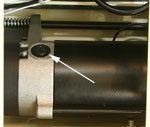 |
The stout DC motor features user-replaceable brushes that allow extending its life span in the unlikely event they wear down. I measured brush length before and after our 40+-hour test and found no measurable wear. Click image to enlarge |
The JET Wet Sharpener is powered by a 110V, (DC) 1.8A, 3,550 RPM DC motor. A DC motor is used to accommodate the variable speed capability. The motor drives the JET Wet Sharpener through direct contact with the shaft and a rubber-covered drive wheel inside the leather honing wheel. The motor shaft is 3/8“-diameter while the wheel it drives is 7 ¼”-diameter. That works out to a 19.333-to-1 ratio that allows the motor to hum along without significant strain under all but the most extreme of loads.
Because this drive system is totally dependent on the friction developed by the motor weight (it is mounted on a pivot), contamination at the shaft and drive wheel by water and/or dust could induce slippage. JET added a “torque” control that with the twist of a knob increases the pressure of the motor shaft against the rubber drive ring that allows finishing the job at hand. This torque-increasing system is remarkable in its simplicity and effectiveness. You keep on working with a consistent rpm and save cleanup for a more convenient time.
Eventually, the many hours of use may cause the surface of the rubber drive ring to glaze over. A light sanding (220-grit paper on a wooden block) instantly rejuvenates that surface and restores its performance.
JET also added a speed control that can be used in two ways. First is compensating for the decreasing diameter (wear) of the grinding wheel. Second is being able to increase or decrease the SFPM (surface feet per minute) to alter the rate at which material is removed to best fit the task at hand.
 |
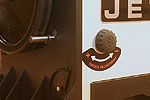 |
The Speed Control (top) and Torque Adjuster (bottom) give the JET Wet Sharpener unique capabilities. Click images to enlarge |
For any grinding wheel to work effectively, it has to shed worn particles to reveal new, sharp ones, a process called friability. That normal loss eventually reduces the diameter of the wheel, slowing the surface speed of the stone by roughly 10% per inch of diameter reduction. That also reduces the SFPM presented to the tool being sharpened. The speed control is infinitely adjustable but has five marked positions, each indicating its RPM (90 to 150 RPM) and the corresponding wheel diameter that setting compensates for. If the grinding wheel has worn down to 7”, setting the speed control to the 7” position increases the wheel RPM so the SFPM returns to the design specification and grinding efficiency is maintained.
Another use for the speed control is increasing the speed/SFPM to increase the grinding effect when considerable amounts of material must be removed such as when re-shaping a tool. After the new shape is established, the operator can dial the speed down to where sharpening is most comfortable.
The speed control also comes in handy when honing tools, particularly those with large bevels. Cranking up the rpm increases the honing action of the leather wheel, shortening the time necessary to create a highly refined edge.
Setup
There is very little that needs to be done to ready the JET Wet Sharpener for use. Installing the grinding wheel and preparing the honing wheel surface is all that is needed. Both procedures are covered well on the included DVD.
The stone grinding wheel on the JET Wet Sharpener is faced while mounted on that machine prior to shipment to be sure it is actually round and ready for use right out of the box. All that remains is saturating it with water.
When stone wheels are cast, they occasionally emerge with a slightly rounded, inconsistent edge that can make the wheel appear to be wobbling. The stone wheel that came with my JET Wet Sharpener looked to be wobbling but when the guide bar was set close to the surface and the wheel turned, the surface proved to be flat and true. After the first couple of truing cuts are taken as the stone wears, that rounded edge and the illusion of wobbling disappears.
The leather-covered honing wheel needs preparation prior to use and is described well on the DVD. Oiling the leather surface before applying the honing paste conditions it while saving time and paste. The oil also prevents the leather honing surface and honing paste from drying out quickly. If the JET Wet Sharpener is not used for an extended period of time, adding a little oil to the honing leather “wakes” it up for use.
The Grinding Wheel
NOTE: The DVD included with the JET Wet Sharpener says the stone wheel has to be trued before use. Since that DVD was produced, JET changed the manufacturing process and now true's the stone wheels prior to shipment.
While the stone wheel on the machine reviewed here was nearly perfect right out of the box, I took a very light cut (less than 1/32” was needed) with the Diamond Truing tool accessory. The cut was to be certain this evaluation and the upcoming comparison to the Tormek began on an even playing field.
Though humans have sharpened things by rubbing them on rocks for thousands of years, modern engineering and chemistry have made it possible to design and fabricate grinding wheels with capabilities our predecessors could not imagine. After using the JET Wet Sharpener for a while, it became obvious they had done their stone-related homework.
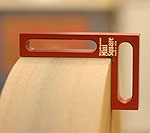 |
JET appears to have struck the delicate balance between friability and durability. This photo was taken after the evaluation was complete, including slightly over 40-hours of sharpening. Note that the side and face of the stone remain square even though no truing cuts were taken after the first one was done before testing began. Click image to enlarge |
The effectiveness of a grinding stone is dependent on its friability, the process of shedding dull particles to reveal new, sharp ones. If the rate at which a stone sheds dull particles is too slow, it “seals over”, (glazes) losing some of its cutting effectiveness. That forces the operator to recondition the surface by grinding away the dull particles or to apply increasing amounts of pressure to regain the grinding effectiveness.
The grinding wheel on the JET Wet Sharpener appears to have this friability factor nailed for use in the home woodworking shop. Throughout the evaluation process, I did not notice the wheels glazing or sealing over. In addition, the edge being sharpened took an edge faster, with less pressure than I am used to. Reducing the pressure needed to grind the edge gives the operator a better sense of control and helps prevent accidental gouging of the stone surface.
A common misconception is that increased friability automatically leads to a shorter life for the grinding stone. The reality is that when the stone cuts faster with less pressure, there is less of a tendency to gouge or wear the stone excessively and unevenly. That translates into less day-to-day wear and fewer cuts to true the surface, resulting in a life span that is frequently longer than seen with harder stone compounds.
Stone Grader
 |
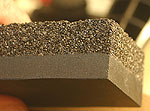 |
The Grading Stone requires less pressure to change the surface (top) than I thought. I often let it "float" when grading the stone to the fine state. The coarse and fine sides (bottom) are easy to distinguish and each produce noticeable changes in how the stone grinds. Click images to enlarge |
The surface of the grinding wheel is fine-tuned with the included two-sided stone grader. The stone grader does not actually change the grit of the stone, as some believe but rather the texture of the surface. Applying the rough side of the block roughens the stone surface slightly, approximating a 220-grit. That increases the speed at which it cuts and the size of the scratch pattern left on the edge. Smoothing the stone surface with the fine side of the stone grader results in a surface that approximates an 800 to 1400-grit. The smoother surface is most often used to finish the sharpened edge. The fine state produces a substantially finer scratch pattern and somewhat slower rate of material removal.
The stone grader allows the user to tailor the stone to the needs at hand. I generally leave the stone in the fine mode as I most often am freshening an edge rather than reshaping it. The effectiveness of the JET Wet Sharpener stone in either the coarse or fine mode makes freshening an edge fast and with the fine scratch pattern, honing the edge is a surprisingly quick operation.
Water Management
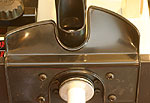 |
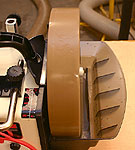 |
Between the inner splash guard (left) and the wide-lipped tanks (right), surprisingly little water winds up on the bench. These are GOOD ideas! Click images to enlarge |
|
Water cooled sharpeners have always had the annoying tendency to deposit water outside of the holding tank. The JET Wet Sharpener is far less annoying because of its wide-mouth tank and a strategically placed catch shield surrounding the end of the carry handle. These simple but well designed features catch nearly all of the errant water that drips from the edges of wider tools such as plane irons during sharpening.
The tank has two sets of mounts, one higher than the other. The upper mount is used to keep the proper amount of the stone wheel submerged when worn to a smaller diameter.
The side panel that encloses the inner workings of the JET Wet Sharpener also catches and deflects water to the outside rather than under or in it. The water management systems on the JET Wet Sharpener may not be perfect but they are a huge step in that direction.
Support Arm
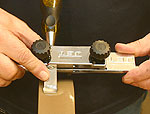 |
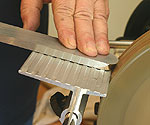 |
Whether installed vertically (left) so the wheel turns into the tool or horizontally (right) where the wheel turns away from the edge, the support arm is solid and easily adjustable. Click images to enlarge |
|
The support arm is used with all of the JET Wet Sharpener jigs, insuring a solid base for consistent sharpening. A thumbwheel on the threaded leg of the support arm makes tiny changes in wheel-to-arm distance simple.
Mounts for the support arm are provided for horizontal (stone turning away from the edge) and vertical (stone turning into the edge) positioning. Being able to choose between these two positions gives the operator substantial control over the speed at which metal is removed from the edge and to a lesser degree, the intensity of the scratch pattern left by the stone.
With the support bar in the top mounts, the action of the stone turning into the edge helps keep it firmly in contact with the stone. This also tends to make the grinding action more aggressive. In addition, less pressure is needed to maintain or further increase that grinding action. While a few jigs are designed to be used with the support bar in the vertical position, most can be used in this position when a lot of material must be removed, such as when changing the angle of an edge or its shape substantially.
For freshening cutting edges or finalizing a major change in angle or shape, I put the support arm in the horizontal mounts so the wheel is turning away from the edge. I find it easier to refine and smooth an edge this way. With the stone graded to its fine state and applying light pressure, the scratch pattern developed is much finer which reduces the time necessary to hone the edge.
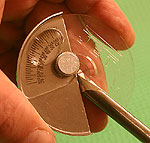 |
 |
 |
The Existing Angle Finder (top) and the Angle Setting Tool (middle) both have rather small numerals that are best seen tilted so the light shines off of them. Setting the tool angle (bottom) is easy thanks to the rounded back end and both wheel diameter and angle settings included on the front leg. Click images to enlarge |
Another benefit of using the support arm in the horizontal position is that it is nearly impossible to gouge the grinding stone. There are few situations that shorten the life of a grinding stone more than cutting a deep gouge with your almost-sharpened tool.
Angle Measuring Devices
A pair of tools are included that make setting the JET Wet Sharpener to establish new or replicate existing angles precise and easy. The Existing Angle Measuring Device (AMD-2) is used to measure an existing edge angle or can be set to the angle desired for checking your progress as the tool is re-shaped.
The Angle Measuring Device (AMD-1) has a pair of scales with matching adjustments and is used to adjust the support arm and jig so the tool is presented to the stone wheel at the correct angle.
In the Shop
When the JET Wet Sharpener arrived, I was nearing the end of a hectic period during which I fell far behind on sharpening most of the cutting edges in the shop. For once my procrastination came in handy, as the timing was perfect for this review. I set my Tormek aside and after 30 minutes of setting up the JET Wet Sharpener, made it the primary sharpening tool for the shop. I also took an hour to watch the included DVD to be sure I understood the functions of the JET Wet Sharpener fully.
The honing wheel has three pins that engage holes in the drive wheel over which it is installed to eliminate slippage. If the honing wheel appears to run out of round, rotating it to another of the three possible positions usually eliminates that problem.
It is important to note that no leather-covered honing wheel runs perfectly true because of the necessary seam. Until someone finds a source for seamless leather rings of the correct diameter, the seam will remain. That little bump is not a big deal and has no impact on the quality of the honed edge.
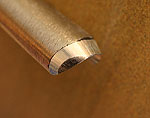 |
This gouge was hand-ground at the factory and while it cut well, the accuracy of the JET jigs corrected the bevel so it was consistent. That made this gouge handle better than new. Click image to enlarge |
It didn’t take long for me to realize the variable speed function had utility beyond correcting the SFPM rate for the wheel diameter. Being able to increase or decrease the rpm is very useful for making the best use of the cutting action of the JET Wet Sharpener wheel in the various edge-grinding situations encountered in the shop.
The speed at which the stone wheel removes material from the edge being sharpened was also a bit surprising to me. The first tool I sharpened was my favorite roughing gouge that had recently been subjected to extended hard use. I had sharpened this gouge many times on the Tormek so had a good feel for the time and effort required to freshen its edge. The JET Wet Sharpener (the stone wheel graded to the coarse state) cut that time by at least a third and required less pressure be applied to the tool than I was accustomed to. After just a few passes I looked at the edge to check my progress but discovered the bevel was already freshly ground from edge to edge and was ready to be refined. A few more passes with the stone graded to the fine state and the edge was ready for honing. I was both impressed and done early.
The stone grader works very well and quickly conditions the grinding wheel surface. The fine side of the stone grader is a bit softer than I anticipated and does wear relatively quickly, especially if substantial pressure is applied. I found that less pressure is needed than you might think to change the stone wheel surface.
The softness of the stone graders fine side is not all bad. Allowing the stone grader to wear more quickly prevents rounding the outside edges of the grinding wheel. This difference in hardness also makes the stone grader less position sensitive. Being able to hold the stone grader in the most comfortable position makes it easier to grade the grinding wheel to the desired grit-state without worry of tapering its surface.
 |
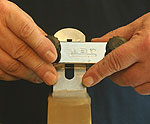 |
The included Straight Edge Jig makes sharpening chisels (left) or even small block plane irons (right) very accurate. Click images to enlarge |
|
During the evaluation period I sharpened everything with a cutting edge (literally EVERYTHING) in the shop, some more than once. Each time the JET Wet Sharpener produced a clean, consistent and super sharp edge. Setting up to re-sharpen edges is fast and replicates the angles precisely.
When turned at the slowest rpm setting the honing wheel works very well. However, I experimented with increased rpm and found the honing process progressed much faster, just as the grinding had earlier. That increased speed in no way compromised the quality of the mirror-smooth finish this honing wheel is capable of producing.
Despite using the JET Wet Sharpener extensively (over 40 hours worth) during this evaluation, I have yet to notice any slippage of the drive that would require use of the torque application system. I must admit giving it a turn just to see what happens but at this point the drive system is so solid that there is no noticeable difference. I suspect the torque application system is more likely to be used much later in the life of the rubber drive wheel. However, it is comforting to know it is there.
The Angle Measuring Device (AMD-1) and Existing Angle Measuring Device (AMD-2) both work well and are easy to use. They make setting edge angles on the JET Wet Sharpener accurately fast and easy. I especially like the layout of the Angle Measuring Device because both the wheel diameter compensation and angle adjustment are on one end. The other end that rests on the grinding wheel is rounded, letting you concentrate on setting the tool.
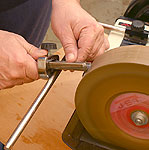 |
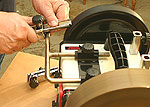 |
Grinding (left) and then polishing (right) even smaller carving chisels is exceptionally fast and easy. The resulting edge is far sharper than new, plus much more consistent across the tool. |
|
The only problem I have with these measuring tools is that their numeric scales are rather small for (my) 50-something eyes. Held at the right angle to the light, the numbers are much easier to read. This is a small problem overall that probably impacts my cohorts in the baby boomer crowd most.
Throughout the evaluation, the water management features worked very well. The amount of water finding its way to the table surface was very small. However, I found out that if you run a full diameter wheel at full speed and fill the tank a bit over the clearly marked maximum line, it does throw some water out. Follow the directions – and abide by the fill line – and water management on the JET Wet Sharpener is first rate.
From day one, the JET Wet Sharpener’s stone grinding wheel removed material faster than I anticipated. Emails from other users of the JET Wet Sharpener echoed this finding with many also commenting on the durability of the grinding wheel. Despite sharpening dozens of tools including bench chisels, plane irons, carving chisels and turning tools, the JET Wet Sharpener grinding wheel has yet to go out of round, develop a concave shape or loose a measurable amount of diameter. The only noticeable change is discoloration, something all water-cooled grinding wheels do in response to grinding debris in the water.
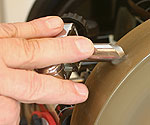 |
I re-shaped my fingernail gouge on the JET Wet Sharpener, having to grind the entire bevel to do so. That process took less than half of an hour from start to having a polished edge. Being able to increase wheel speed helped in both grinding and honing. Click image to enlarge |
The variable speed control, though designed primarily to compensate for decreasing grinding wheel diameter, has turned out to be very useful for grinding and honing. Being able to increase the rpm takes the already fast material removal properties of the JET Wet Sharpener grinding wheel to new levels that make reshaping a cutting edge much faster than I am accustomed to. I find myself using the speed control frequently and enjoy the new level of control it affords over grinding and honing.
Despite claims to the contrary by the Tormek camp, I did not experience appreciable slowing of the JET Wet Sharpener during the 40-some hours of evaluation in my shop. Similar experiences have been related by several other JET Wet Sharpener users, also based on their in-shop experience.
I have only been able to induce a small, momentary rpm loss by intentionally applying sudden, excessive pressure on the tool being sharpened. This level of pressure is unwarranted in any sharpening situation on the JET Wet Sharpener I am aware of. The fast-cutting properties of the JET Wet Sharpener grinding wheel makes application of sufficient pressure to slow it a clear sign that your overbearing side has emerged or you want to sell a competing machine.
During the evaluation I found the JET Wet Sharpener easily handled literally every cutting edge I could find in my shop. In each case, the edge was restored or shaped as needed faster than I anticipated. Another surprising characteristic of the JET Wet Sharpener is how refined the edge is when the grinding stone is conditioned to the fine state. Very often, the edge appeared nearly polished directly from the grinding wheel.
Video Tour! |
Tools that are normally used with the bevel rubbing were quickly honed smooth. This rapid transformation is due in part to the reduced scratch pattern left by the grinding wheel, the effectiveness of the honing wheel and the ability to increase rpm for those operations.
The accuracy of the JET Wet Sharpener jigs is also an important consideration. Even high-end carving and turning tools benefit from grinding super-sharp, consistent cutting edges. Being able to repeat such consistent edges makes these tools easier to use because they work the same way each time they are put to wood. This is helpful for veteran users but is especially important to those trying to learn to use these and many other types of cutting tools.
Conclusions
The JET Wet Sharpener is a very capable machine with unique capabilities that make it especially useful in the woodworking shop. The solid construction and durable grinding wheel mean the JET Wet Sharpener will have a very long life with minimal maintenance by the user.
Pricing Link |
With a street price of $299.99 (9-29-2006) the JET Wet Sharpener is an exceptional value. The traditional reliability of JET-manufactured tools and a remarkable 5-year warranty mean this is a long-term investment that will pay dividends in your shop for many years to come.
If you use cutting tools, adding the JET Wet Sharpener to your shop will make life easier, safer and more accurate. Sharp, consistent cutting edges are crucial to everything from turning on the lathe to chiseling mortises on the bench. Being able to restore a razor-sharp edge in your own shop when you need it will save time and the expense of visiting the local sharpener.
Resources
JET Wet Sharpener/Tormek SuperGrind Comparison
Have a comment on this review? - Email Me!
All written, photographic and drawn materials are property of and copyright by NewWoodworker.com LLC 2000-2019. Materials may not be used in any way without the written permission of the owner.
